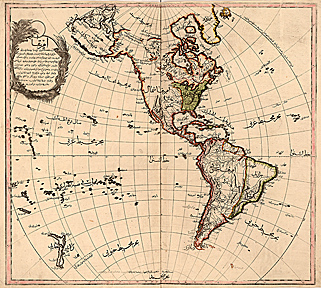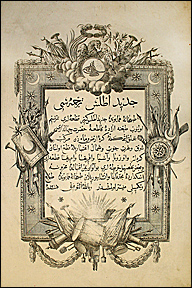| |
Western hemisphere in Turkish text.
New Great Atlas [Cedid atlas tercümesi], Istanbul, [1803-1804].
Original in the John Carter Brown Library.

< click on image for enlargement >
|
Title page to
New Great Atlas [Cedid atlas tercümesi], Istanbul, [1803-1804].
Original in the John Carter Brown Library.

< click on image for enlargement > |
|
The New Great Atlas:
Istanbul, 1803-1804
by Allison Rich
Very few people have a clear understanding of what a cataloguer does, much less a cataloguer who deals in rare books and special collections. Cataloguing is not so much of a science as it is an art. My cataloguing teacher at Simmons College in Boston, Sheila Intner, was always fond of saying Turn off your brain and catalogue. Well, thank goodness, its not that way in the rare books world. I very much need to actively think and utilize my love of languages and history in order to describe the item to such a degree as a researcher in Oslo or Madrid or Lima can get a mental picture of the item in question. I have often likened rare books cataloguing to writing an historical essay in machine readable form. If I make an assertion as to the identity of an author, I must back it up with proof, which comes from a national library catalogue online or a well known bibliography in the field.
The most important skill for a rare books cataloguer to possess is a mind which revels in detail and puts effort into a full level record. A minimum level record with an author, title, truncated place of publication, and a haphazard physical description will simply not do. Moreover its not useful for anything other than a place holder or inventory marker in a collection. A full level record must have all these above, fully fleshed out, copious notes, and subject headings which allow you to locate the items in the automated library catalogue. All of this information gets entered in a MARC (i.e. Machine Readable Cataloguing) record which is taken by the specific library vendor—in our case Innovative Interfaces—and becomes the record you see on the screen when you search in the OPAC.
Once and a while the Library has purchased an item which I am not able to work on at all because its in a language that I dont understand (say Russian) but which other members of staff at the JCB can read. However, there will sometimes be an item in a language which no one on the staff understands and requires me to seek out the help of those who do. Such an item was purchased in 2007 from a book dealer in London—The New Great Atlas, printed in Istanbul, 1218 [i.e. 1803 in the Gregorian calendar]
I started looking into cataloguing the New Great Altas in November of 2010, but could not actually finish it until March of 2011. It had to be put aside while I worked on other things.
The New Great Atlas [Cedid atlas tercümesi] was the first Islamic world atlas to be based on European geographic knowledge. It was printed in Istanbul in the year 1218 in the Islamic calendar by the Ottoman Military Engineering School [Tab'hane-yi Hümayun] and was bound with Mahmud Raif Efendis [died 1807] geographic study on the maps entitled Ucaletü'l-coğrafiyye. The maps themselves were based on William Fadens [1749-1836] plates for his General atlas, first printed in London, 1797. Mahmud Raif Efendi composed his eighty page commentary in French when he was private secretary to the Ottomon ambassador in London. The commentary was translated into Turkish by the Turkish charge d'affaires in Vienna, Yakovaki Efendi. The atlas was part of Sultan Selim IIIs [ruled 1789-1807] Nizam-i cedid [or New order], which was an attempt to incorporate European knowledge and administration in to the Ottoman system. The place names on the maps are transliterated into the Arabic script and all of the Christian symbols have been erased. Only fifty copies of the New Great Atlas were printed.
All of this information could be established from the book dealers description. But, not knowing Turkish, how was I actually to work with the transliteration of the title from the Arabic script into the Turkish language? As a cataloguer, one just cannot take things on faith. It is necessary and desirable to find a native speaker to confirm that what you have in your hand is actually what is there. This was my first quandary.
I was informed of the existence of a professor in the Brown Language Department named Engin Akarli, who was an Ottoman specialist. I located his email, and wrote him requesting his help and attached an image of the title page in question. Professor Akarli graciously returned not only a transliteration of the Arabic script in the Turkish language, but also an English translation of the text, along with informative notes.
Professor Akarlis transliteration of the title read thusly:
Cedid Atlas tercemesi Tab'hâne-i Hümâyun'da Cedid Atlas-i kebîr kit'alari tersîm olunub tab'ina irâde-i katie-i hazrit-i cihândarî taalluk etmegle, küre-i arz ve maidan mürekkeb şark ve garb [ve] cenûb şimâl i'tibâriyle kat olunan küreler ve Avrupa ve Asya ve Afrika ve Amrîka ve baz-i tafsîl haritalari [nin].
His transcription of the imprint read thusly:
Bu evan-i yumn-i ikbâlde Mahrûse-i Üsküdar'da müceddeden ibnâ ve inşa buyurlan Tab'hâne-i Hümâyûn'da tab' ve tekmîli müyesser olmuşdur ve billâhi-tevfik. Sene 1218.
I was thrilled to have the transcription from a native speaker and scholar. Furthermore, Professor Akarli informed me that the printing house was called Dâr ul-Tibâat ul-Cedîde as well as the Üsküdar Matbasi after the place in which it was built. He wrote that the printing house published its first book in 1802 and that a calligrapher, named Hafiz Osman Resmî, and an engineer, known as Arapoglu, an Armenian-Ottoman citizen, were in charge. The government moved the printing house to Bayezit and combined it with another printing house already existing there in 1831. From henceforth it became known as Matbaa-i Âmire [the Imperial Printing House].
Now that I had a transliteration by a native speaker and scholar such as Professor Akarli, I needed to check how it conformed to the accepted transliteration standards from the Library of Congress. I was put in contact with Allen Mayberry, Senior Cataloguing Specialist, and Turkish language cataloguer. I sent him the transliteration done by Professor Akarli who said it was acceptable but suggested some changes in order to make it conform to LC transliteration standards thusly:
Cedid atlas tercümesi [.] Tab'hane-yi Hümayun'da Cedid atlas-i kebir kit'alari tersim olunup tab'ana irade-yi kati-yi hazrat cihandarî taalluk etmekle; küre-yi arz ve mâdan mürekkep şark ve garb canub ve şimal i'tibarile kati olunan küreler ve Avrupa ve Asya ve Ifrikiye ve Amrika ve baz-i tefsil haritalari. Bu evan-i yumn-i ikbalde mahruse-yi Üsküdar'da müceddeden bina ve insa buyurlan Tab'hane-yi Hümayun'da tab' ve tekmili müyesser olmusdur ve bi-Allah'l-tevfik, sene 1218. [1803 or 1804]
He told me that he needed to correct the transliteration found in the record as it was catalogued by the Library of Congress and asked me not to do our record or attach our holding to their record until he had done so. During the next few months, I focused on other things until I was ready to take it up again at the end of March of this year.
I contacted Allen Mayberry again and asked if it was alright for me to continue to work on our Atlas record. And he sent me a corrected transliteration (see above) again and tried to answer any questions I might have about this atlas. I wanted to know about arrangement and location of the commentary by Mahmud Raif Efendi within the volume, and whether Ottoman Turkish was read from right to left. I also had a question about the number of maps in the Altas. He told me that, indeed, Ottoman Turkish was read from right to left and that the commentary by Mahmud Raif Efendi appeared after the title page. The title page in our copy was bound in the middle of the volume, following the maps. Our copy was also clearly bound in the west where the front board opens out to the left, and the foredge of the text block is facing right as opposed to being bound in Turkey, where the font board opens out to the right and the foredge of the text block is facing left. I had found a blueprint from the French firm of Simantob frères for a distillery in Tehran, Iran, located following the rear flyleaf, also leading me to believe that the book had been in France at some point. Now I had to examine the number of maps. In the Library of Congress’s catalogue record the page count was given as: [3], 79 p., 50 leaves (some folded).. The "50 leaves" meant that each leaf of both left and right sides of a map are counted, which results in 25 double maps. I only counted 46 leaves [i.e. 23 double maps] which meant that our copy seemed to be missing two double maps."
I wrote to Allen Mayberry yet again asking him about this and he volunteered to go down and look at the copy of the Atlas which they owned. Several hours later, I heard from him and it was made clear that we were lacking 2 double maps, that of the continent of Europe and another of the continent of Africa. Allen sent me a detailed description of each of the maps, which I put into my catalogue record, in addition to the notation which indicated in which order our mpas were bound and noting the missing plates. Allen had gone above and beyond the call of duty in helping us with our Atlas.
Up until 1998, when the Library of Congress acquired their Atlas and wrote up their description it was the only copy held outside of Turkey. They commented that, of the fifty copies printed, one special copy had been presented to Selim III, six others were given to important state officials, and two were placed in the library of the Engineering School [Tab'hane-yi Hümayun]. Prior to the Library of Congresss purchase, only six complete copies were known to exist, all of which were in Istanbul: one at the Topkapi Palace, two at the Engineering School, and three in the collection of
Boğaziçi University.
The John Carter Brown Library acquired our copy in 2007. And since then two more copies have appeared in US Libraries: The Newberry Library, in Chicago, who has an incomplete copy, and, most recently, Princeton University, who does hold a complete copy.
That is the story of how the New Great Atlas was catalogued at the JCB. Huge thanks must go out to Professor Akarli and Allen Mayberry, without whose kind help our Atlas would have never been properly catalogued. You can find the JCBs catalogue record here. |


